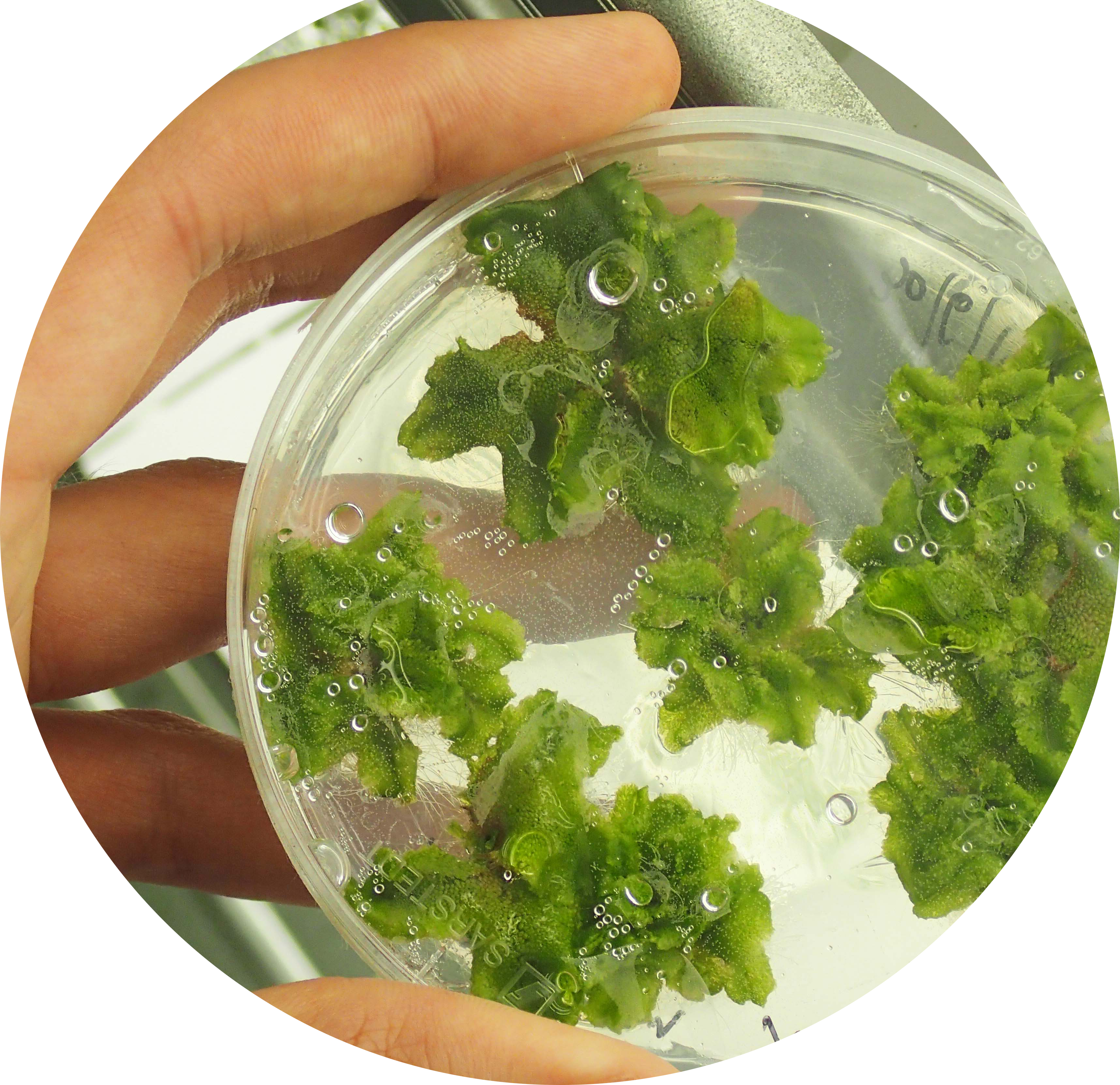Team:Cambridge-JIC
From 2014.igem.org
| (8 intermediate revisions not shown) | |||
| Line 33: | Line 33: | ||
<div class="clearfix"></div> | <div class="clearfix"></div> | ||
<h2 class="section-heading">mösbi - a plant biosensor for everyone</h2> | <h2 class="section-heading">mösbi - a plant biosensor for everyone</h2> | ||
| - | <p class="lead"><b>mӧsbi</b> stands for <b>m</b>archantia <b>o</b>pen-<b>s</b>ource <b>bi</b>osensor. mӧsbi encapsulates the team's vision of creating a user-friendly, open-source biosensor using the liverwort <i>Marchantia polymorpha</i>. With its sturdy genetic framework and modularity, mӧsbi represents a new step in popularising synthetic biology and making it accessible to a large audience | + | <p class="lead"><b>mӧsbi</b> stands for <b>m</b>archantia <b>o</b>pen-<b>s</b>ource <b>bi</b>osensor. mӧsbi encapsulates the team's vision of creating a user-friendly, open-source biosensor using the liverwort <i>Marchantia polymorpha</i>. With its sturdy genetic framework and modularity, mӧsbi represents a new step in popularising synthetic biology and making it accessible to a large audience. Click <a href="https://2014.igem.org/Team:Cambridge-JIC/Project/Overview">here</a> to find out more.</p> |
</div> | </div> | ||
</div> | </div> | ||
| Line 49: | Line 49: | ||
<div class="clearfix"></div> | <div class="clearfix"></div> | ||
<h2 class="section-heading"><i>Marchantia polymorpha</i> as a new chassis</h2> | <h2 class="section-heading"><i>Marchantia polymorpha</i> as a new chassis</h2> | ||
| - | <p class="lead"> <i><b>Marchantia polymorpha</b></i> is our novel, eukaryotic multicellular chassis. Being a liverwort, it is one of the most primitive land plants around. Its small size and relative genetic simplicity make it easy to work with and an exciting new model organism in synthetic biology. Content to grow on agar plates, marchantia can be bioengineered in a standard lab with minimal extra equipment. Click <a href="https://2014.igem.org/Team:Cambridge-JIC/Marchantia/Background">here</a> to find out more about the plant and our work to develop the chassis; and <a href="https://2014.igem.org/Team:Cambridge-JIC/Guide | + | <p class="lead"> <i><b>Marchantia polymorpha</b></i> is our novel, eukaryotic multicellular chassis. Being a liverwort, it is one of the most primitive land plants around. Its small size and relative genetic simplicity make it easy to work with and an exciting new model organism in synthetic biology. Content to grow on agar plates, marchantia can be bioengineered in a standard lab with minimal extra equipment. Click <a href="https://2014.igem.org/Team:Cambridge-JIC/Marchantia/Background">here</a> to find out more about the plant and our work to develop the chassis; and <a href="https://2014.igem.org/Team:Cambridge-JIC/Guide">here</a> to learn how to get started using <i>Marchantia</i> in your own iGEM project.</p> |
</div> | </div> | ||
<div class="col-lg-3 col-sm-pull-7 col-sm-6"> | <div class="col-lg-3 col-sm-pull-7 col-sm-6"> | ||
| Line 71: | Line 71: | ||
<div class="clearfix"></div> | <div class="clearfix"></div> | ||
<h2 class="section-heading">Results</h2> | <h2 class="section-heading">Results</h2> | ||
| - | <p class="lead">We successfully transformed hundreds of individual plants, resulting in the first expression of chromoproteins in | + | <p class="lead">We successfully transformed hundreds of individual plants, resulting in the first expression of chromoproteins in <i>Marchantia</i>, and probably the first expression of chromoproteins in any plant. We successfully built an arduino-controlled growth chamber, characterised an enzyme new to iGEM and amended the community's knowledge of an existing registry entry. A known <i>Marchantia</i> promoter was also added to the registry, along with 27 candidate promoters from the <i>Marchantia</i>genome. They are part of a <i>Marchantia</i> starter kit part collection that also includes terminators, direction sequences, etc. Finally, we submitted an RFC with collaboration of two other iGEM teams, establishing a unified Type IIS based grammar for plant synthetic biologist: PlantSyntax. Click <a href="https://2014.igem.org/Team:Cambridge-JIC/Results/Lab">here</a> for more result details, and <a href="https://2014.igem.org/Team:Cambridge-JIC/ExecSummary">here</a> for our executive summary.</p> |
</div> | </div> | ||
</div> | </div> | ||
| Line 99: | Line 99: | ||
| - | + | ||
| - | + | ||
| - | + | ||
| - | + | ||
</body> | </body> | ||
</html> | </html> | ||
Latest revision as of 01:17, 18 October 2014

mösbi - a plant biosensor for everyone
mӧsbi stands for marchantia open-source biosensor. mӧsbi encapsulates the team's vision of creating a user-friendly, open-source biosensor using the liverwort Marchantia polymorpha. With its sturdy genetic framework and modularity, mӧsbi represents a new step in popularising synthetic biology and making it accessible to a large audience. Click here to find out more.
Marchantia polymorpha as a new chassis
Marchantia polymorpha is our novel, eukaryotic multicellular chassis. Being a liverwort, it is one of the most primitive land plants around. Its small size and relative genetic simplicity make it easy to work with and an exciting new model organism in synthetic biology. Content to grow on agar plates, marchantia can be bioengineered in a standard lab with minimal extra equipment. Click here to find out more about the plant and our work to develop the chassis; and here to learn how to get started using Marchantia in your own iGEM project.


Results
We successfully transformed hundreds of individual plants, resulting in the first expression of chromoproteins in Marchantia, and probably the first expression of chromoproteins in any plant. We successfully built an arduino-controlled growth chamber, characterised an enzyme new to iGEM and amended the community's knowledge of an existing registry entry. A known Marchantia promoter was also added to the registry, along with 27 candidate promoters from the Marchantiagenome. They are part of a Marchantia starter kit part collection that also includes terminators, direction sequences, etc. Finally, we submitted an RFC with collaboration of two other iGEM teams, establishing a unified Type IIS based grammar for plant synthetic biologist: PlantSyntax. Click here for more result details, and here for our executive summary.
Our team
We are 9 Cambridge science undergraduates from various backgrounds and with all kinds of fascinating and curious interests. Click here to learn more about the team.

 "
"


